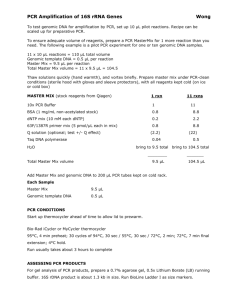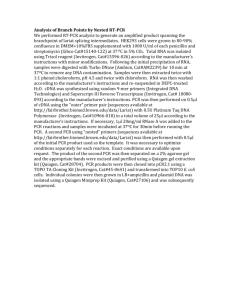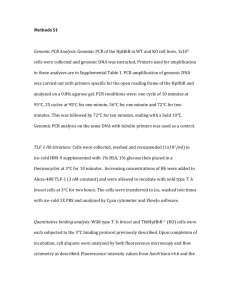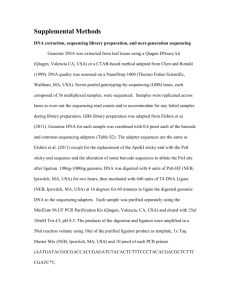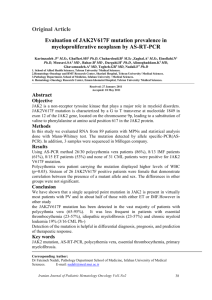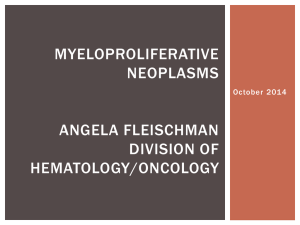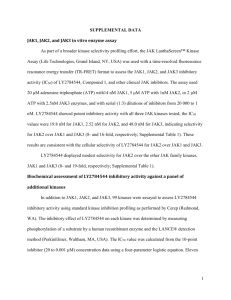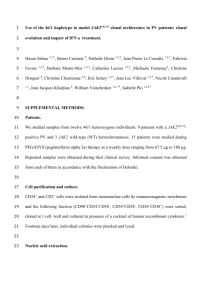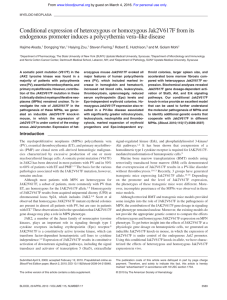SUPPLEMENTARY Materials and Methods Preparation of genomic
advertisement
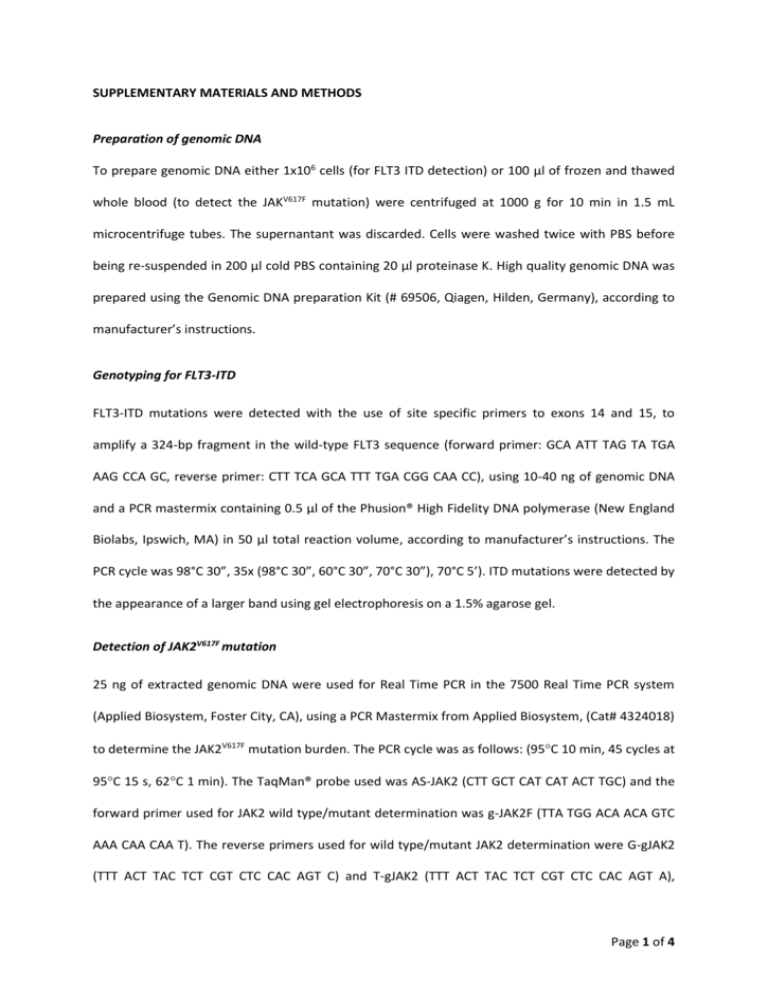
SUPPLEMENTARY MATERIALS AND METHODS Preparation of genomic DNA To prepare genomic DNA either 1x106 cells (for FLT3 ITD detection) or 100 μl of frozen and thawed whole blood (to detect the JAKV617F mutation) were centrifuged at 1000 g for 10 min in 1.5 mL microcentrifuge tubes. The supernantant was discarded. Cells were washed twice with PBS before being re-suspended in 200 μl cold PBS containing 20 μl proteinase K. High quality genomic DNA was prepared using the Genomic DNA preparation Kit (# 69506, Qiagen, Hilden, Germany), according to manufacturer’s instructions. Genotyping for FLT3-ITD FLT3-ITD mutations were detected with the use of site specific primers to exons 14 and 15, to amplify a 324-bp fragment in the wild-type FLT3 sequence (forward primer: GCA ATT TAG TA TGA AAG CCA GC, reverse primer: CTT TCA GCA TTT TGA CGG CAA CC), using 10-40 ng of genomic DNA and a PCR mastermix containing 0.5 μl of the Phusion® High Fidelity DNA polymerase (New England Biolabs, Ipswich, MA) in 50 μl total reaction volume, according to manufacturer’s instructions. The PCR cycle was 98°C 30”, 35x (98°C 30”, 60°C 30”, 70°C 30”), 70°C 5’). ITD mutations were detected by the appearance of a larger band using gel electrophoresis on a 1.5% agarose gel. Detection of JAK2V617F mutation 25 ng of extracted genomic DNA were used for Real Time PCR in the 7500 Real Time PCR system (Applied Biosystem, Foster City, CA), using a PCR Mastermix from Applied Biosystem, (Cat# 4324018) to determine the JAK2V617F mutation burden. The PCR cycle was as follows: (95C 10 min, 45 cycles at 95C 15 s, 62C 1 min). The TaqMan® probe used was AS-JAK2 (CTT GCT CAT CAT ACT TGC) and the forward primer used for JAK2 wild type/mutant determination was g-JAK2F (TTA TGG ACA ACA GTC AAA CAA CAA T). The reverse primers used for wild type/mutant JAK2 determination were G-gJAK2 (TTT ACT TAC TCT CGT CTC CAC AGT C) and T-gJAK2 (TTT ACT TAC TCT CGT CTC CAC AGT A), Page 1 of 4 respectively. The mutation burden of the sample was calculated according to the following formula: JAK2 V617F%=[copy number of V617/(copy number of V617F+copy number of wild type)]*100%. All percentages above 0% indicate the presence of the JAK2V617F mutation. pFLT3 ELISA The pFLT3 capture ELISA (Cat#7206) from Cell Signaling Technologies was used according to manufacturer’s protocol. Briefly, tumor lysates were thawed on ice, protein concentrations were measured and equal amounts of protein were assayed in duplicates. Flow cytometry For cell cycle analysis, 5 x 105 /ml MV4-11 cells were treated for up to 72 hr with 0.1 µM TG02. Cells were fixed using 70% ice-cold ethanol and stained with 20ng/mL propidium iodide (BD Biosciences). For apoptosis analysis, cells were treated with 0.1 µM TG02 and stained using the Annexin V-FITC apoptosis detection kit from BD Biosciences (Franklin Lakes, NJ), according to manufacturer’s instructions. To characterize expanded progenitor cells or AML blasts, cells were labeled with monoclonal antibodies against CD71 and CD235A or CD34, CD38 and CD123 respectively, and analyzed on a FACSCalibur equipped with CellQuest Pro software (BD Systems, San Jose, CA). Pharmacokinetic analysis TG02 was extracted from 50 μL of plasma or from tissue homogenized in 0.5 mL PBS. High performance liquid chromatography mass spectrometry analysis was done on a Waters Alliance HT2795/QuattroMicro (Waters Corp., Milford, MA) using a C8 column (2 X 5 mm, 5 µm Zorbax, Quantum Analytics, Foster City, CA). Samples were resolved using an isocratic run with a mobile phase consisting of 70% methanol and 30% of 0.1% formic acid in water, at a flow rate of 0.3 mL/min. The tandem mass spectrometry conditions for multiple reaction monitoring for TG02 were transitions of mass to charge ratio (m/z) of 473 to m/z 96.8 and m/z 237 to 194 for the internal standard carbamazepine respectively, both in electrospray ionization-positive mode. The cone voltage (CV) was 40 V with collision energy (CE) of 35 eV for TG02 and 20 V / 35 eV for Page 2 of 4 carbamazepine. The assay was linear between 1 and 1000 ng/mL and the lower limit of quantitation was 1 ng/mL. Non-compartmental pharmacokinetic analysis was performed using WinNonlin (version 5.1, Pharsight Corp., CA). The AUC was estimated by using the linear trapezoidal method. Dose proportionality, which was assessed by linear regression of day 12 AUC0-∞ and Cmax with dose, as well as statistical analyses were performed using Prism 5. Cell proliferation assay Cells were seeded in 96-well plates at a predetermined optimal density, in the log phase and rested for 2 h, prior to drug treatment for 48 h. All experiments were performed in triplicates in 9 serial dilution steps, and cell viability was measured using CellTiter 96 ® Aqueous One Solution Cell Proliferation MTS Assay (Promega, Madison, WI). Primary erythroid progenitor cells Blood was drawn from consented donors at Tan Tock Seng Hospital, Singapore (IRB approval number DSRB-B/08/159) and PBMCs were purified using Becton Dickinson Vacutainer® CPT™ tubes (Franklin Lakes, NJ). Progenitors were expanded from PBMCs using a published protocol.9 In brief, 3 x 105 cells/ml were cultured in the StemSpan® Serum-Free Expansion Medium in the presence of 100 ng/ml of FLT3 ligand, 100 ng/ml of thrombopoietin and 100 ng/ml of stem cell factor, diluted from the cytokine cocktail CC110 (StemCell Technologies). On day 4, the remaining viable cells were purified using Ficoll histopaque (GE LifeScience, Uppsala, Sweden) and re-plated in the same medium. On day 8, cells were seeded at 5 x 105 cells/ml in a second-step medium (SFEM containing 50 ng/ml of stem cell factor, 50 ng/ml of insulin-like growth factor-1, and 3 U/ml of erythropoietin). Expanded progenitors were re-plated at 3 x 104 cells /ml in the same medium on day 12 for treatment. On day 10 to 13, expanded cells were harvested, counted on the Z1 Particle Counter and aliquoted as follows : ~ 1 x 105 cells for JAK2V617F analysis, ~ 5 x 105 cells for FACS, ~ 3 x 106 cells for proliferation assay. Western blot assays Page 3 of 4 Cell lysis, protein quantification and Western blots were performed as described previously.12 Western blotting was performed using antibodies against pRb S807/811 (#9308), Rb (#9309), pFLT3 Y591 (#3461), pSTAT3 Y705 (#9145), pJAK2 Y1007/1008 (#3776), Mcl-1 (#4572), Cyclin E (#4129), Bcl2 (#3498), cdc6 (#3387), cleaved PARP N214 (#9541) and secondary antibodies, all purchased from Cell Signaling Technology (Danvers, MA). The antibody against pSTAT5 (Y694, Cat #611965) was from BD Biosciences (San Jose, CA) and anti-phospho-RNA polymerase II Ser2 (ab70324) was from Abcam (Cambridge, UK). Antibodies against -actin and α-tubulin were from Sigma Aldrich (Cat# 2066; St. Louis, MO) and Millipore (Cat# 05-829; Billerica, MA) respectively. Signals were detected using the LAS-3000 (Fujifilm, Tokyo, Japan) at normal sensitivity using either ECL substrate (GE Life, Little Chalfont, U.K.) or SuperSignal Western Dura Chemiluminescent substrate (Pierce, Rockford, IL). Page 4 of 4

